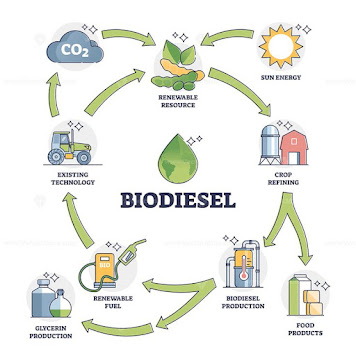Nutrient Cycles
Nutrient cycles, also known as biogeochemical cycles, refer to the processes by which nutrients are recycled within an ecosystem. These cycles involve the movement of nutrients through various living and non-living components of the environment, ensuring a continuous supply of essential elements for life.
There are several nutrient cycles that play vital roles in maintaining the balance of nutrients in ecosystems. Some examples include:
1. Carbon Cycle:
The carbon cycle involves the movement of carbon in various forms, such as carbon dioxide (CO2) and organic carbon compounds, through the atmosphere, soil, oceans, and living organisms. It includes processes like photosynthesis, respiration, decomposition, and combustion.
2. Nitrogen Cycle:

The nitrogen cycle involves the conversion of nitrogen gas (N2) from the atmosphere into forms that can be taken up by plants and used by organisms. This cycle encompasses processes such as nitrogen fixation, nitrification, denitrification, and assimilation.
3. Phosphorus Cycle:
The phosphorus cycle is the movement of phosphorus, primarily in the form of phosphate (PO4^3-), through soil, water, and living organisms. It involves processes like weathering, absorption by plants, consumption by animals, and return through decomposition.
4. Water Cycle:
While not strictly a nutrient cycle, the water cycle is crucial for the distribution and availability of water, which is essential for life. It involves processes such as evaporation, condensation, precipitation, and transpiration.
5. Sulfur Cycle:
The sulfur cycle involves the biogeochemical transformations of sulfur compounds, including sulfate (SO4^2-) and hydrogen sulfide (H2S), in the environment. It includes processes like sulfate reduction, oxidation, and assimilation.
6. Oxygen Cycle:
While oxygen (O2) is not considered a "nutrient" in the traditional sense, it plays a crucial role in many biochemical processes and is essential for sustaining life. The oxygen cycle involves the continuous exchange of oxygen between the atmosphere, bodies of water, and living organisms through processes like photosynthesis, respiration, and diffusion.
7. Calcium Cycle:
The calcium cycle involves the movement of calcium (Ca2+) through various components of the ecosystem, including rocks, soil, water, and living organisms. Calcium is vital for the structural integrity of bones, shells, and cell membranes. It cycles through processes like weathering, erosion, absorption by plants, consumption by animals, and excretion.
8. Iron Cycle:
The iron cycle encompasses the movements and transformations of iron (Fe) in the environment. Iron is an important micronutrient required by many organisms for processes like oxygen transport, energy production, and enzyme activities. The cycle involves processes such as weathering, sedimentation, absorption by plants, consumption by animals, and release through decomposition.
9. Potassium Cycle:
The potassium cycle involves the movement of potassium (K+) through rocks, soil, water, and living organisms. Potassium is a vital mineral nutrient required by plants and animals for various physiological processes, including maintaining osmotic balance and enzyme functions. It cycles through processes such as weathering, uptake by plants, consumption by animals, and release through decomposition.
10. Hydrogen Cycle:
The hydrogen cycle refers to the movement and transformation of hydrogen (H) within the environment. Hydrogen plays a central role in many biochemical reactions and serves as an energy carrier. While hydrogen exists in various forms, its cycle involves processes such as water vaporization, condensation, hydrogen gas production by bacteria, and hydrogen uptake and release by living organisms.
These examples illustrate the interconnectedness and interdependence of nutrient cycles within ecosystems. Efficient nutrient cycling ensures the availability of essential elements for organisms, promotes energy flow, and supports the overall health and functioning of ecosystems.
Here are some questions related to nutrient cycles along with sample answers:
1. What is a nutrient cycle?
Sample answer: A nutrient cycle refers to the movement and recycling of essential elements or nutrients through various pathways in ecosystems. These cycles involve the uptake, utilization, and release of nutrients by plants, animals, and microorganisms.
2. How does the carbon cycle operate?
Sample answer: The carbon cycle is the process through which carbon is continuously exchanged between the atmosphere, land, oceans, and living organisms. It involves several key steps, such as photosynthesis, respiration, combustion, and decomposition.
3. Explain the role of decomposition in nutrient cycling.
Sample answer: Decomposition plays a crucial role in nutrient cycling by breaking down organic matter, such as dead plants and animals, into simpler compounds. This process releases essential nutrients, such as nitrogen, phosphorus, and carbon, back into the ecosystem, making them available for reuse by other organisms.
4. What is nitrogen fixation, and why is it important in nutrient cycles?
Sample answer: Nitrogen fixation is the process by which atmospheric nitrogen (N2) is converted into a chemically reactive form that can be used by living organisms, such as ammonia or nitrate. This conversion is necessary because most organisms cannot directly use atmospheric nitrogen. Nitrogen fixation is important because it increases the availability of nitrogen in the ecosystem, which is an essential component of proteins, DNA, and other organic compounds.
5. How does the water cycle influence nutrient cycles?
Sample answer: The water cycle plays a significant role in nutrient cycling as it transports and redistributes nutrients through precipitation, runoff, and evaporation. Water carries dissolved nutrients, such as nitrates and phosphates, from the land to rivers, lakes, and oceans, where they can be utilized by aquatic organisms. Additionally, precipitation replenishes freshwater supplies, which are important for maintaining biological processes and nutrient availability on land.
6. Discuss the human impacts on nutrient cycles.
Sample answer: Human activities, including agriculture, industrial processes, and deforestation, have significantly disturbed nutrient cycles. Excessive use of fertilizers leads to nutrient runoff, which causes eutrophication in water bodies. Deforestation disrupts nutrient cycling by reducing the organic matter input into soils. The combustion of fossil fuels releases large amounts of carbon dioxide into the atmosphere, contributing to climate change and altering the carbon cycle.
Remember that these are just sample answers, and you can expand on them or personalize them based on your specific knowledge and research on nutrient cycles.








Comments
Post a Comment